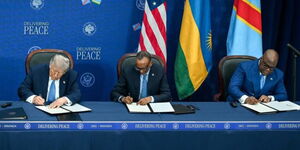A report prepared by five United Nations (UN) organizations ranked Kenya among 63 countries hosting some of the hungriest people in the world.
The report, State of Food Security and Nutrition In the World, was jointly published by the United Nations International Children's Education Fund (UNICEF), World Food Programme (WFP), World Health Organization (WHO), Food and Agricultural Organization (FAO) and International Fund for Agricultural Development (IFAD)
The researchers collected data from 2019 to 2021 and showed about 14.4 million Kenyans were facing hunger.
The report presents the first global assessment of food insecurity and malnutrition for 2020 and offers some indication of what hunger might look like by 2030 in a scenario further complicated by the enduring effects of the global pandemic.
It further showed that the number of people affected by hunger globally had increased to 828 million in 2021, which was an increase from 46 million in 2020 and 150 million since the outbreak of the pandemic.
The increase in hunger was attributed to inequalities of class across countries and different patterns of economic recovery caused by the pandemic.
The findings confirm Kenya's poor performance in achieving zero hunger - a critical area under the Sustainable Development Goals (SDGs) that was supposed to help the country meet Vision 2030.
The daily cost and affordability of a healthy diet in Kenya has grown by Ksh14 per person from 2017 to 2020. In 2017 for example, a Kenyan would spend about Ksh336 to afford a healthy meal but the figure had risen to Ksh350 in 2020.
But as things stand now, not many Kenyans can afford a healthy diet due to harsh economic hardships caused by unemployment and drought.
In April, Public Service CS Margaret Kobia noted that about three million Kenyans, especially in arid and semi-arid lands, were facing starvation due to drought.
World Health Organization (WHO) Director-General Tedros Adhanom Ghebreyesus noted that 11 million people, globally, die every year as a result of unhealthy diets.
“Rising food prices mean this will only get worse. WHO supports countries’ efforts to improve food systems through taxing unhealthy foods and subsidizing healthy options, protecting children from harmful marketing and ensuring clear nutrition labels,” the WHO boss advised.
The publishing organisations indicated that even as the world recovered from a pandemic that has caused major setbacks, there was much to be learned from the vulnerabilities and inequalities it has laid bare.
If taken to heart, these new insights and wisdom could help get the world back on track towards the goal of ending hunger, food insecurity, and malnutrition in all its forms












